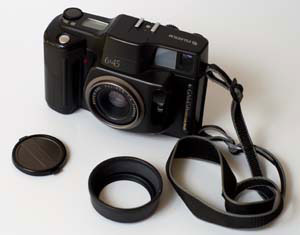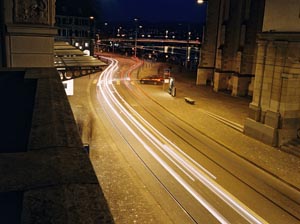 If you define a professional camera as one that actually says professional on it, then the Fuji GA645 was my first pro caliber photo tool. When first released in the early 1990’s it went for something near to 1500 USD. Now they are commonly found on eBay for 300-500 USD. For professionals it means a camera with near point-and-shoot convince and killer tack-sharp medium format “pop”. It really is point-and-shoot. You depress the shutter button half-way, it focuses, depress further, it takes the picture. Given its geometry and size, the GA645 is easy to hold steady in low-light situations. As I mainly do travel and landscape with this camera. The lens is a 60mm Fujion with an f/4 aperture. Many people have found fault with this design, complaining that f/4 is just too slow, the same people who have shot down the Sigma DP1, which sports an f/4 objective. Of course, numbers on paper are just that, in practice I haven’t found the f/4 lens to be limiting. Toss in some ISO 400 or 800 speed film and you have the ability to shoot in low-light situations, and since you’re shooting with a 6×4.5 film size, the quality of the resulting image will still be fantastic, especially for such a mobile camera design. The automatic focus however, can be a bit frustrating. Every camera has limitations, and the autofocus is what adds a rain-cloud texture to the overall fantastically sunny experience of shooting with a GA645. See, once in a while I get my negatives or transparencies back and find the subject was out of focus and blurry. For this reason, in general the GA645 is best used for static subjects. The focus distance is displayed in the viewfinder, so you can always look there to make sure it’s about right. It’s also possible to do manual focusing, which is nice because the focus was easily fooled when I traversed from Bettmerhorn to Eggishorn in intermittent fog cover in the Swiss Alps. Shooting into the rising sun can also screw with the focus system, and in such situations I set the focus to infinity. Despite the autofocus limitations, the metering system is dead-on and I rarely have any exposure problems.
If you define a professional camera as one that actually says professional on it, then the Fuji GA645 was my first pro caliber photo tool. When first released in the early 1990’s it went for something near to 1500 USD. Now they are commonly found on eBay for 300-500 USD. For professionals it means a camera with near point-and-shoot convince and killer tack-sharp medium format “pop”. It really is point-and-shoot. You depress the shutter button half-way, it focuses, depress further, it takes the picture. Given its geometry and size, the GA645 is easy to hold steady in low-light situations. As I mainly do travel and landscape with this camera. The lens is a 60mm Fujion with an f/4 aperture. Many people have found fault with this design, complaining that f/4 is just too slow, the same people who have shot down the Sigma DP1, which sports an f/4 objective. Of course, numbers on paper are just that, in practice I haven’t found the f/4 lens to be limiting. Toss in some ISO 400 or 800 speed film and you have the ability to shoot in low-light situations, and since you’re shooting with a 6×4.5 film size, the quality of the resulting image will still be fantastic, especially for such a mobile camera design. The automatic focus however, can be a bit frustrating. Every camera has limitations, and the autofocus is what adds a rain-cloud texture to the overall fantastically sunny experience of shooting with a GA645. See, once in a while I get my negatives or transparencies back and find the subject was out of focus and blurry. For this reason, in general the GA645 is best used for static subjects. The focus distance is displayed in the viewfinder, so you can always look there to make sure it’s about right. It’s also possible to do manual focusing, which is nice because the focus was easily fooled when I traversed from Bettmerhorn to Eggishorn in intermittent fog cover in the Swiss Alps. Shooting into the rising sun can also screw with the focus system, and in such situations I set the focus to infinity. Despite the autofocus limitations, the metering system is dead-on and I rarely have any exposure problems.
 The Fuji GA line sports a few accessories, which one is still able to pick up if one is so inclined. A flash bracket and flash we produced, the basic GA bracket is shown here. Somehow I’ve acquired one bracket and two flashes, both of which I never actually use with my GA645. If you do use them however, the flash exposes very nicely with a butter popping sound. The bracket has a tilting head, so when you rotate the camera to shoot in landscape orientation, you can rotate the flash 90 degrees (similar to the Sony HVL-58). I sometimes use the bracket with my Minolta 7D. Since neither is produced anymore, they can be had on the used market for either reasonable or absurd prices. The one useful accessory I do use often is the tripod bracket. It lets you mount the camera and rotate around the axis of the lens, perfectly balanced and engineered. A macro attachment is also available, but doing macro work without being able to check the actual focus is bit hit and miss – and with medium format film, a tad expensive.
The Fuji GA line sports a few accessories, which one is still able to pick up if one is so inclined. A flash bracket and flash we produced, the basic GA bracket is shown here. Somehow I’ve acquired one bracket and two flashes, both of which I never actually use with my GA645. If you do use them however, the flash exposes very nicely with a butter popping sound. The bracket has a tilting head, so when you rotate the camera to shoot in landscape orientation, you can rotate the flash 90 degrees (similar to the Sony HVL-58). I sometimes use the bracket with my Minolta 7D. Since neither is produced anymore, they can be had on the used market for either reasonable or absurd prices. The one useful accessory I do use often is the tripod bracket. It lets you mount the camera and rotate around the axis of the lens, perfectly balanced and engineered. A macro attachment is also available, but doing macro work without being able to check the actual focus is bit hit and miss – and with medium format film, a tad expensive.

 The general risk with buying old discontinued Pro technology is that, if it breaks – you’re screwed. So it’s actually sort of cool that you can still send in the GA645 to Fuji for a tune-up. About two years ago I picked up some surplus GA645 parts from eBay, including some shutters and body pieces, so aside from Fuji, I’m somewhat confident I could fix basic problems should they arise. The Fuji GA line is just the start, you can also get into the GW and GSW cameras, which can be bough in 6×7, 6×8, and 6×9 versions, all offering jaw-dropping razon tack-sharp images. So getting down to Brass-Tax, in the age of digital sensors and megapixels the Fuji GA645 is a film camera which still rocks hardcore. If you have some spar funds I highly recommend picking one up.
The general risk with buying old discontinued Pro technology is that, if it breaks – you’re screwed. So it’s actually sort of cool that you can still send in the GA645 to Fuji for a tune-up. About two years ago I picked up some surplus GA645 parts from eBay, including some shutters and body pieces, so aside from Fuji, I’m somewhat confident I could fix basic problems should they arise. The Fuji GA line is just the start, you can also get into the GW and GSW cameras, which can be bough in 6×7, 6×8, and 6×9 versions, all offering jaw-dropping razon tack-sharp images. So getting down to Brass-Tax, in the age of digital sensors and megapixels the Fuji GA645 is a film camera which still rocks hardcore. If you have some spar funds I highly recommend picking one up.Read more about the GA645 at dante stella.
